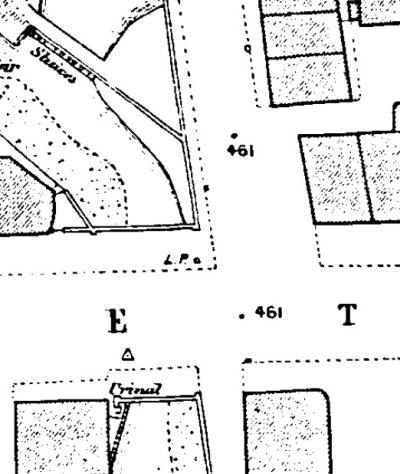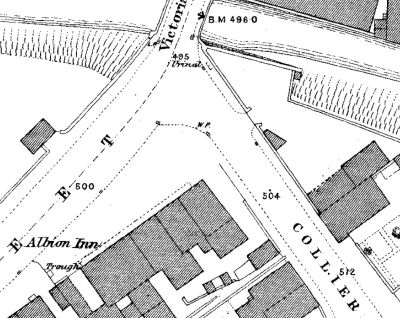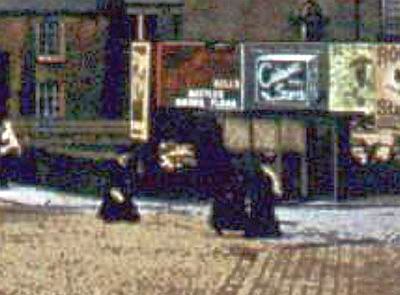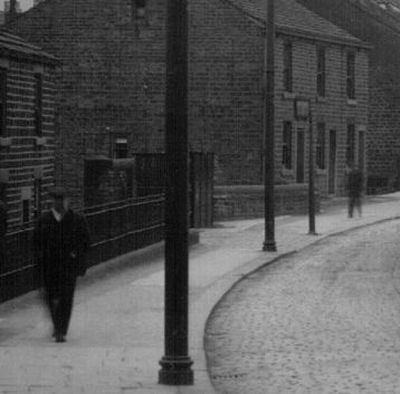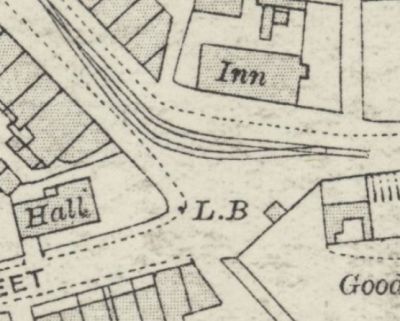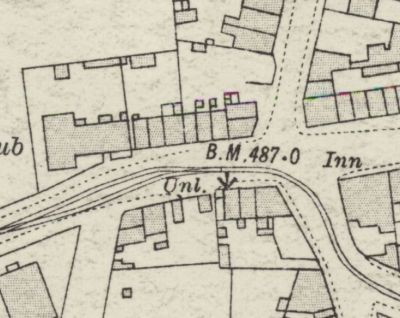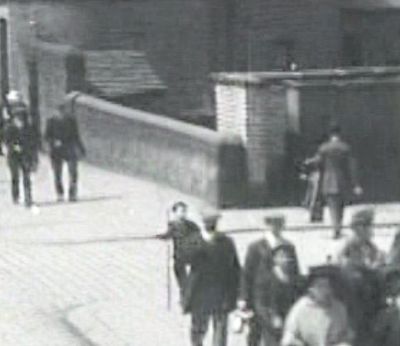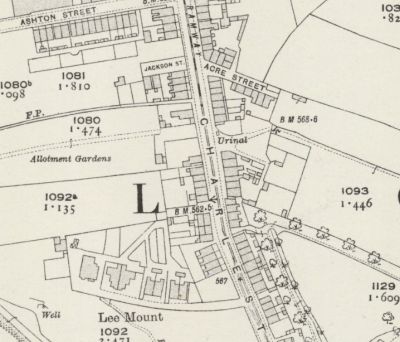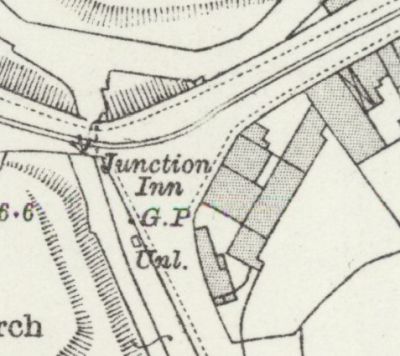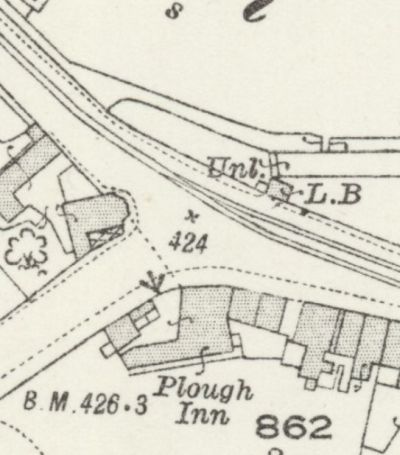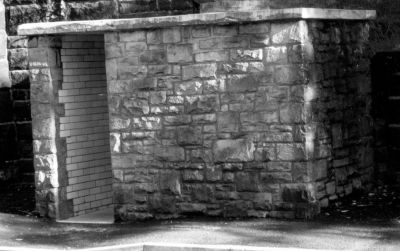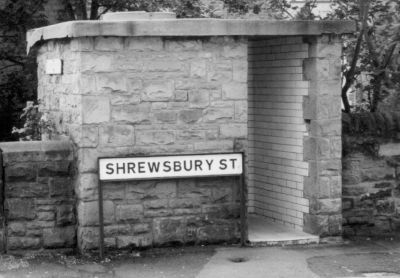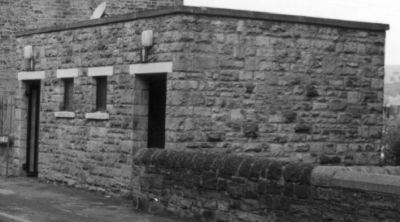A Matter of Convenience.
Some time ago, whilst discussing things that are no longer found in Glossop with Mike Brown, public urinals (as opposed to public conveniences) were mentioned. The comment was made that it would not be long before nobody would remember them. That is, perhaps, not surprising when, apart from one, all the local ones have been replaced/demolished. The one that does survive is on Dinting Vale, across from the end of Glossop Road (though even that isn't certain as there was a similar bus shelter next to the urinal).
This is a brief history of Glossop's public urinals gleaned from contemporary newspapers and personal recollections. Thanks to Mike Brown for photos to supplement my own.
The Public Health Act 1848 provided, at section LVII, “And be it enacted, That the Local Board of Health may, if they think fit, provide and maintain, in proper and convenient Situations, Waterclosets, Privies, and other similar Conveniences for public Accommodation, and defray the necessary Expenses out of the District Rates to be levied under this Act.”.
It was, though, several years later that Glossop would be furnished with such Public Necessaries. Even then, in keeping with the attitude of the day, the first ones were male urinals rather than the sorts of public conveniences for both genders which we are used to today.
The earliest mention found of a urinal in Glossop was in a letter, on an unconnected subject, in the Glossop Record of 3 March 1860 which referred to “a very prominent urinal close to Milltown Toll Bar”. That urinal was probably the one at what was then the Swan Inn (78 High Street East), which is marked on the 1880 Town Plan. At that date the only urinals in the town were probably those outside pubs provided for customers (the 1880 Town Plan also shows them at the Rose & Crown, Howard Arms, Manor, Hare & Hounds and Ring o' Bells).
A letter to the Editor, published in the Glossop Record of 9 January 1864, appealed for provision of a public urinal in Norfolk Square. The letter read:
Sir, My vocation being in the streets, I consider it my duty to bring before the notice of the public, any thing which I consider is a flagrant abuse of the privileges we pedestrians are allowed. I am fond of clean streets, and decorous conduct observed by all who traverse them ; but I am sorry to say such is not the case, for any person who will take the trouble to walk through Norfolk Square as often as I do, he will there see practised daily - nay hourly - a most intolerable nuisance, all for the want of a proper urinal. The wall at the end of the Norfolk Hotel is becoming loathsome in the extreme, and rather unpleasant to my olfactory nerves. The most fashionable part of the town is polluted by this stagnant stream, and if you will pass by the corner of that wall at the dead hour of night, the stench arising will remind you of a too close approximation to a something which ought not publicly to exist, and which I hope will soon be obviated by the erection of a proper urinal. In all other towns, even those of lesser import than my own, such “conveniences” may be seen; then why not Glossop have them? Are we lost to all sense of respect and “street courtesy,” as to render us indifferent to our “street morality”? I hope not, and providing the suggestion may not be acted upon for some time, one thing might be carried out at once - which is, to rail off that part of which I complain, thereby removing one grievous eye-sore from the gaze of your correspondent, and all others whose business is connected with the streets.
Yours Respectfully, The Man in the Streets.
No records have been found of when further public urinals were actually built but a meeting of the Waterworks Committee on 20 May 1885 heard that there were three conveniences of the kind in the town. They were presumably the ones shown on the 1880 Town Plan on High Street West opposite the end of Shrewsbury Street, on High Street East at Cornmill Bridge and on Victoria Street at the foot of Collier Street.
Further provision followed in the next 20 years or so. At the General Purposes Committee of 4 May 1887, Members wanted to know why the public urinals which were ordered to be erected adjoining the railway bridge in Arundel Street, had not been placed in position and said they ought to be put in their places without delay because a great nuisance existed near the bridge, especially on Sundays. The position is shown by the 1919 map extract below.
The Sanitary Committee of 4 September 1889 decided to have sides fixed to the urinals at Victoria Bridge and also Corn Mill Bridge, with a view of making them more private. Photos below.
The Sanitary Committee of 29 October 1890 appointed a sub-committee to select a site for the erection of an iron urinal in Station Road, Hadfield. They didn't work very quickly, it being 25 April 1894 before they reported beak recommending that one of metal be erected near to the station yard, at the top of Station-road, and another - a circular one - near to the “Red Lamp”. They also recommended that the landlord of the Palatine Inn be approached about having his existing urinal taken down, and another erected elsewhere on the premises. A year later the drains for the one near the station were in place and the urinal was ready for erecting when objections were received from Mr. William Pollitt, general manager to the M.S.&L. Railway Company (who thought it would detract from the company's premises), and local councillors who thought the urinal was “a most paltry thing” when they had expected something more ornamental. After further discussion it was decided that the urinal remain, but that a screen be put in front of it. It was to be another ten years or so, after pressure from both councillors and the Glossop and Hadfield Trades Council before the urinal at Bankbottom was built. These extracts from the 1919 OS Map show the positions of the urinals. Note that the one near the station is the square block level with the Letter Box, rather than being in the position of the current, more modern convenience.
The writer of the Stray Notes column in Glossop-dale Chronicle and North Derbyshire Reporter 29 August 1890 complained about the sanitary, or rather insanitary, condition of the Market-street, pointing out that there were two fully-licensed public-houses and a vaults in the street, and yet there was not one decent public urinal. He refused to “attempt to describe the unseemly sights to be witnessed opposite the back entrances to the shops comprising the Town Hall buildings where, I regret to say, not only men but women may be seen forgetful of their modesty”.
At the Town Council on 17 February 1892, Sanitary Committee it was pointed out that, despite the erection of a urinal being agreed months previously, nothing had happened. The matter was ordered to be proceeded with but nothing happened until 1907 when, following complaints about the Market toilets, the council decided to consider the question of erecting a public convenience in Norfolk Square. Lord Howard’s Agent suggested the Market Place as an alternative and the Surveyor prepared plans of the conveniences for the Market Ground for males and females but it was not proceeded with as the cost was too high.
In February 1909, Lord Howard brought forward another, cheaper, scheme but that was also not proceeded with on cost grounds. Lord Howard made another proposal but the Council decided not to alter its previous decision.
By the following January, Lord Howard had decided that it was of the utmost importance that there should be proper public conveniences provided in the town for both males and females. He proposed to close the old ones in the Market, and to build new ones in the market ground at his own expense, the Council to keep them in order and provide an attendant. Standing orders prevented the Council discussing the matter so soon after the last time so it was put in abeyance until June 1910. The cost had then dropped enough for the council to approve it and it looked like the work would take place. In the event, another spanner was thrown in the works. The General Purposes Committee meeting of 13 July 1910 received a letter from the Howard Estate Office which said that Lord Howard had found that he could not carry out his ideas regarding the building of new lavatories, etc., upon the Market Ground (which seemed to be so necessary) “on account of the greatly increased taxation the Government have thought fit to impose upon his Glossop Estate.”. It was to be several years more before the Market Ground convenience was built (lack of records means the exact date has not been identified).
The urinal near Shrewsbury Street was moved across the road by 1911 as it can be seen in the film taken from the tram of that year (the 1919 OS Map showed the location).
During roughly the same period, suggestions of provision in other areas had been suggested, including the building of underground urinals which was also rejected for cost reasons. In addition to the still outstanding (at that time) Bankbottom, the vicinity of Whitfield Church and the fountain, opposite the Plough Inn at Dinting and the tram terminus at Old Glossop were put forward. Once again, the matter was put in the hands of a sub-committee.
At the Town Council meeting on 13 September 1905 a strong case was made for the provision of a pubic urinal at the Junction, Dinting. There was no urinal right away from the bottom of Shrewsbury Street in High Street West to Woolley Bridge (owned by the Spread Eagle) and people were being caused to go into the Junction Inn and get drink when they didn't want it, just so that they could use the facilities.
Meetings on 15 August 1907 received a letter from the Glossop, Hadfield, and District Trades Council advocating the erection of a urinal on Charlestown and the sub-committee was given the job of finding a suitable spot for erecting one. They appeared to find a site fairy quickly but the matter was still outstanding in March 1909 when the Trades Council decided to write the Sanitary Committee again (and to complain about the poor maintenance of the urinal near Hadfield Station). The extracts from the 1919 OS Map show the positions of the urinals at Charlestown, The Junction and The Plough.
By the time the second world war ended the urinals were in need of repair.
The one at the Spread Eagle was so bad it was removed. Typically, it took several years to find a new site and then the owner's illness held up negotiations so it was 1959 before it could be finalised.
The main barrier to replacement of the others (in some cases by public conveniences rather than simply urinals) was government permission to borrow/spend money.
An underground facility at Norfolk Square was considered but never built.
The urinal at the top of Station Road, Hadfield was replaced by Ladies' and Gents’ Lavatories.
The urinals at the Junction and Bankbottom were removed.
Work on replacements started in 1955 but was not completed until 1956 due to the contractor having difficulties in obtaining materials. The photos show the new urinals at Arundel Street and Shrewsbury Street and the full conveniences at Station Road.
As mentioned at the beginning, all the “necessaries” which were urinals only have since been replaced, demolished or decommissioned.
Return to GJH.me Home Page, Return to Glossop Area Local Histories index.
Last updated: 1 August 2022
